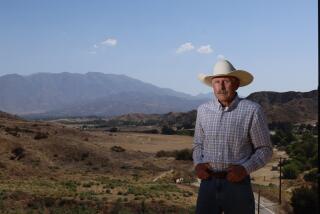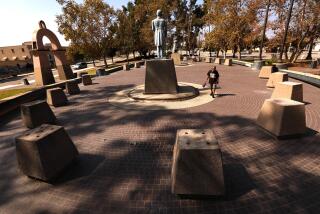Modern Temple of Commerce to Join Pyramids
- Share via
SAN JUAN TEOTIHUACAN, Mexico — After 14 centuries, this village is ready to face the next big thing.
Just a mile from the legendary pyramids of Teotihuacan, site of Mexico’s best known pre-Hispanic relics and symbols, is the expected new home of Wal-Mart, one of the 21st century’s most famous symbols of consumerism and globalization.
It has become the latest point of contention in the battle between modernization and preservation of Mexico’s indigenous and colonial character. Like the recently built McDonald’s in Oaxaca and Costco in Cuernavaca, the Wal-Mart will almost certainly open because economic concerns are likely to trump cultural ones.
The majority of townspeople apparently can’t wait for the grand opening, but some call it a travesty.
The Wal-Mart opponents -- many of whom belong to a group called Civic Front -- say the store will pollute the ambience and harm the archeological remnants of a prehistoric city that 14 centuries ago encircled the two Teotihuacan pyramids. They claim that the store will be an eyesore, visible from the 200-foot summit of the Pyramid of the Sun.
“We don’t want to prostitute our national symbols for the betterment of a corporation,” said Emanuel D’Herrera, a schoolteacher who is leading the admittedly scant opposition in this town of 15,000 that has grown up on the western edge of the 8-square-mile archeological zone.
Some shopkeepers also are dreading the opening, saying they can’t hope to match Wal-Mart’s prices. “It’s going to kill us,” said Irma Gonzalez Rodriguez, who runs a poultry shop in the town’s central market. “How are we going to compete against that giant?”
In August, a group of protesters blocked the entrance to the construction site and roughed up an architect for the project, prompting the company to complain to police. But most residents interviewed last week said they were eagerly awaiting the December opening of the store that will carry the logo of Bodega Aurrera, a smaller-scale Wal-Mart. They complain of high prices and a small selection of merchandise in the town’s mom-and-pop stores and of having to drive 30 miles north to Pachuca for discount shopping.
“Progress has to come someday,” said Olga Morales, owner of a gift shop near the central square. “It won’t hurt my business, it might even help. Tourists don’t come here. They drive to the pyramids from the capital for the day, then go back.”
Merchant Alberto Aguilar Valadez said: “It’s a good idea. It won’t harm the culture. It might even give it more prominence because more people out in the countryside will come here to buy their necessities.” Others said the 180 jobs that the Wal-Mart will generate will be good for a local economy that lacks industry.
To some, claims that the Wal-Mart will destroy the pre-Hispanic ambience also seem a bit of a stretch, given that it is across a bridge and a busy two-lane highway that separate the town from the principal archeological zone.
“In no way will the project have a negative impact, not in the visual, not in the cultural sense, not on people, not on anthropology. There is no problem whatsoever,” said Guillermo Rodriguez, mayor of San Juan Teotihuacan. The local City Council unanimously approved the store, about 30 miles from Mexico City.
The Wal-Mart will be painted in earth tones, with a brass-colored sign approved by the National Institute of Anthropology and History, or INAH, spokesman Raul Arguelles said Tuesday. Next to the construction site is a garishly painted Elektra department store that seems a greater threat to the town’s aesthetic character.
“Here the stores lack many things -- variety, hardware, household goods, electronics -- that Wal-Mart will bring,” said Florentino Sarabia, a local resident. “For me, it’s a good thing.”
Opposition to the project seems moot: INAH, which regulates all construction in and around the nation’s archeological treasures, has given the project a green light, saying that surveys over the last 40 years have turned up no evidence of pre-Hispanic structures on the Wal-Mart site. UNESCO’s International Council on Monuments and Sites also approved the project.
But members of the Civic Front and other opponents haven’t given up. “We have hope, and we have right on our side,” said Ramon Garcia, a resident and land-use consultant who is a member of the group.
Opposition was energized Aug. 25 when Wal-Mart’s two on-site archeologists discovered the floor of a pre-Hispanic structure on the edge of the site where a store parking lot will be paved. INAH ordered a suspension of construction but later said the project could go ahead. In a statement, UNESCO said after an inspection that building over the remains “did not represent a risk to the preservation of the archeological zone’s integrity.”
The Wal-Mart property is bordered on one side by a centuries-old pre-Hispanic canal that at one time probably was lined with houses, but apparently no major structures.
Wal-Mart and its affiliate stores and restaurants are common sights in cities across Mexico. With its payroll of 106,000, Wal-Mart has become Mexico’s largest private employer.
More to Read
Inside the business of entertainment
The Wide Shot brings you news, analysis and insights on everything from streaming wars to production — and what it all means for the future.
You may occasionally receive promotional content from the Los Angeles Times.










